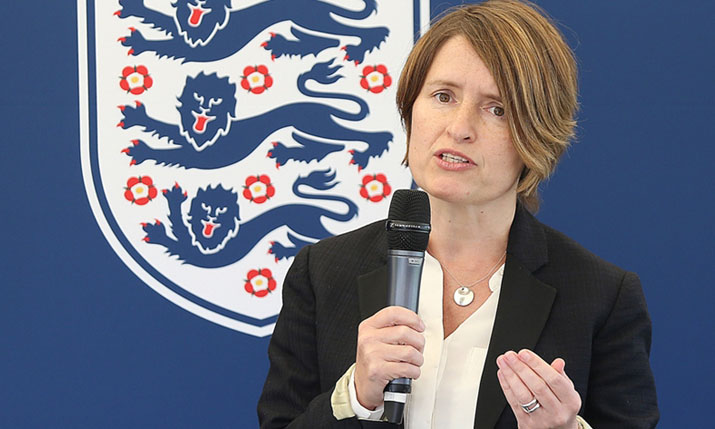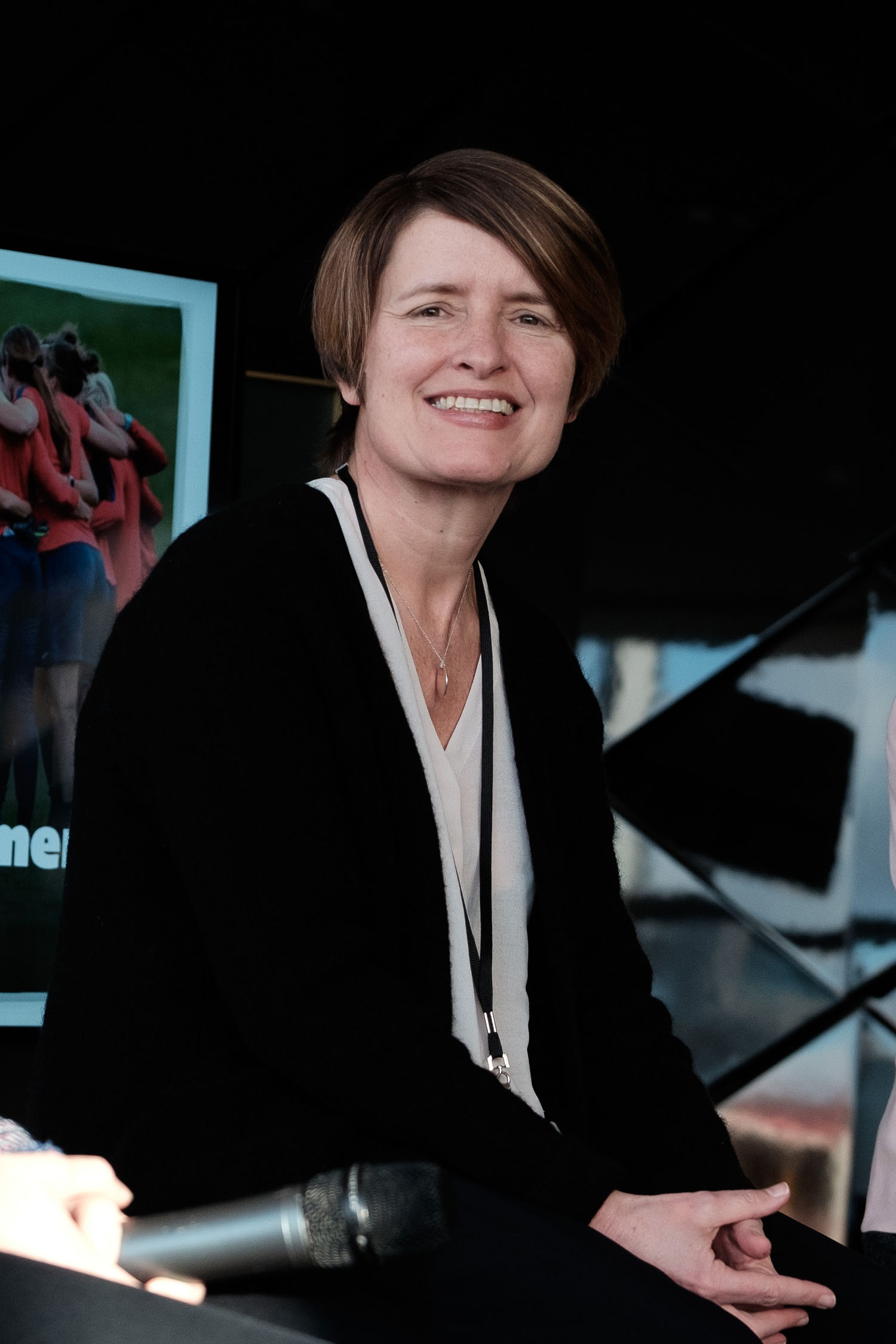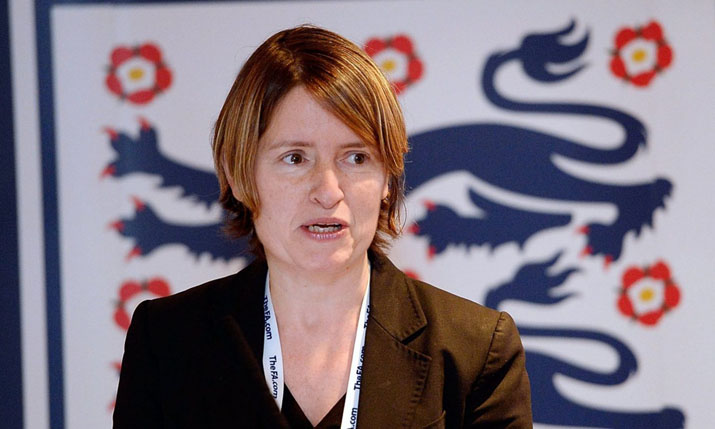A life of football by accident: The FA’s director of the women’s professional game Kelly Simmons talks goals

Kelly Simmons, director of the women’s professional game at The FA
The Football Association (FA) established the Women’s Super League in 2011, and in 2018 it went fully professional for the first time. Overseeing the development of women’s and girl’s football under the auspices of the FA is Kelly Simmons, director of the women’s professional game.
Simmons is focused on the entire gamut of the domestic women’s professional game, from grass roots growth and encouraging girls to play, to the top level league that is taking this sport into the realms of mainstream popularity.
Women’s sport has got a lot more press than usual this year. On the significance of the Women’s World Cup to the overall popularity of the women’s game, Simmons comments: “It was massive. The semi final moment is the second most-watched television programme of any sport on television this year [following the Rugby World Cup final]; 11.7 million were watching the semi final. Why’s that important? Because we’ve been trying to break down cultural barriers as we’ve developed the game. We’ve come a long way, but there are still perceptions that it’s a male sport or women’s football isn’t great to watch, or whatever these stereotypes and perceptions are, -they have just been smashed through these global and domestic audiences.
“FIFA announced their audience [reach for the Women’s World Cup 2019] recently and globally it was over a billion [1.12 billion viewers watched coverage of France 2019], and that means a huge audience has seen top quality women’s football and has been coming back in more and more numbers throughout that tournament. They’ve seen it, they’ve enjoyed it, and they’re engaged in it.”
Capitalising on momentum
The Women’s World Cup was a key moment in the growth of the women’s game, says Simmons: “I think when we look back at 2019, we’re going to go, ‘wow, something really happened there’.”
She adds that the Women’s World Cup is now followed by another two events that are enabling her to continue to push the women’s game through the FA: “We’ve had three incredible years, with the World Cup in a great time zone having been held in France, we’ve got the Olympics and we’ve qualified which is fantastic so we’ve got that to look forward to, and then we’ve got the UEFA Women’s Euro Championships in England which is going to be phenomenal and the BBC have bought the rights and it’s going to be huge.
“So it’s not just a one off and capitalising on that,” she notes, referring to the Women’s World Cup, “It’s three years with fantastic pinnacle events too hook everything to, and make sure we keep women’s football high and visible in the public eye.”
On 2 September this year the FA launched FA Player, a new live streaming platform, exclusively dedicated to women’s football. FA Player, which is free to use and available online and via a dedicated mobile app, provides live access to over 150 domestic women’s football fixtures throughout the season. BT Sport, host broadcaster for the Women’s Super League, and the BBC are continuing their regular coverage with over 30 live games televised across the 2019-20 season, with FA Player created to broaden access beyond traditional channels free of charge in a single destination.
As to why it decided to go over the top (OTT) with its own channel, Simons says the FA noticed through research it carried out internally that more could be done to bring the sport to fans. She explains: “From our research, we were only getting max two games out a week, and not every house has BT Sport so people don’t know where to go to find women’s football. We thought an OTT offering was really important as part of building that fan base.”
The FA have already beaten their internal target of people registering for the FA Player channel by the end of the year, from its launch in September. However, says Simmons, “we smashed it in the first week.” She adds: “We didn’t have a lot to benchmark that figure against, but we smashed it so we’re now resetting the targets for the year.”
The launch of FA Player and production of those extra games has already paid off, increasing the women’s games reach. Since the channel launched, the FA has already signed three overseas TV distribution deals for the content on the channel and it is tendering for an agency to help it do further deals, and, “there are more in the offing,” Simmons adds. “This is starting to produce revenues in terms of overseas TV rights,” says Simmons. “We’re really pleased!”
FA Player’s fast growing popularity is also helping the FA to set the women’s game up so that, like the men’s leagues, it is possible for clubs in the lower leagues to get promoted into the professional top tier.
Simmons explains: “[FA Player has] also giving us the opportunity to put a weekly FA Women’s Championship match on, which is really important because it’s really vital we support the second tier clubs to enable them to grow their audience, attendances and revenue, because otherwise you’d end up with a closed league by accident; if you don’t support both [tier one and tier two] leagues, you’d struggle to promote teams and meet the criteria for professional football because the gap [between semi-professional and professional football] would end up being too big. So [FA Player] has helped us get Championship games out there as well.”

The Women’s World Cup was a key moment in the growth of the women’s game, says Simmons: “I think when we look back at 2019, we’re going to go, ‘wow, something really happened there’.”
Counting pinnacle moments
Simmons says what she terms as “pinnacle moments” – such as sports World Cups, European Championships, and the Olympics – events with great focus, brand commitment and eyeballs at home on them, hold audience imaginations temporarily, but until now breaking from those pinnacle events into mainstream sporting popularity has been the territory of male sports only.
She says: “No women’s sport has broken through [from those kind of pinnacle events] into the regular, domestic mainstream, in a visible way like men’s cricket, football and rugby has. With the exception of probably women’s basketball in America, I can’t think of a commercially viable professional women’s sports league.”
Simmons goes on: “I genuinely think the Women’s Super League has got a fantastic chance of breaking through into the mainstream. Over the next five to seven years it will become commercially sustainable, so I think [we are now facing] a fantastic challenge in women’s sport and women’s football. The women’s sport has come a long way in a very short time from a pretty low base, in terms of profile and revenue and audiences.”
On the road to commercial sustainability, she adds: “The timeline is not set in stone yet as we’re developing the strategy with the new board; one of the first jobs we did [when the Women’s Super League went professional last year] was put in a new board. We had a strategy meeting about three weeks ago and we’re just finessing that strategy now, but ultimately, depending on how much you want to invest, you’re probably looking at five to seven years before [the women’s Super League] could wash its face and survive in its own right.”
Many clubs are investing in the women’s game, joining the FA’s vision of growing the game. “We’re investing together for the foreseeable future before we see a return on that,” said Simmons.
BT Sport along with BBC Sport and brands like Barclays, which did a record sponsorship deal for women’s sport in Europe in its support as title sponsor for the Women’s Super League, are all part of this momentum pushing women’s football forward, from grass roots to pro.
“I don’t think football sits in isolation from the rest of society. Today, people expect to see more diversity, to see more inclusion, and they expect brands that are investing in communities or investing in sports to invest in men and women,” notes Simmons.
Life of football by accident
Simmons got into the football industry completely by accident. After gaining her coaching qualification at university, where she also played football, a sabbatical year to be the sports officer at her university after she completed her degree led her to Manchester University to do a similar role around their sports development and sports competitions, “which wasn’t the plan at all, because I was supposed to be going back [to university] to do a Masters in social work,” she notes.
“Then the FA rang me and said ‘we’re starting to look at women’s football, would you come in and have a chat?’.” Simmons began working for the FA coaching coaches and teachers and trying to put some infrastructure into the game, skilling up the workforce to develop girl’s football in clubs and schools.
Simmons adds: “I hadn’t planned to work in football because I didn’t think was any career in football, it never even entered my head. There was no visibility of women’s football or women in football [then].”
She was then promoted to head up girl’s and women’s development in football at the FA. Working with the then technical director for the FA, Howard Wilkinson, in the late 1990s she began developing the women’s section of the blueprint of the Charter for Equality for the FA, which is still a key strategy for the association.
Simmons explains: “It had the vision for the national football centre in it at St George’s Park, boy’s academies, mini soccer, the right format of the game for children, and I developed proposals in there for which we got funding and agreement for, which set up for a full time national coach, all the England Youth Teams, and Centres of Excellence for girls.”
When her equivalent on the boy’s side of the FA left to become an academy director at Tottenham FC, Simmons then became head of development for the merged boys and girls sides of the game. She eventually became director of development, responsible for children’s and grass roots football.
“We invest about £50 million to £60 million a year into community football, county FA’s, and more,” she comments.
Finally, as the Women’s Super League went professional following the 2017-2018 season, a new job was created to oversee it and Simmons took up her current role as director of the women’s professional game, looking at the development of professional women’s football in September 2018. “So, a life of football really, by accident!”
Changing perceptions of women

Kelly Simmons, from The FA
Simmons was not allowed to play football at school, which she says is one of her, “big driving forces,” in her work today. She explains: “Why I’m so passionate about helping to leave a legacy for this generation to have much, much more opportunity than I had. I remember trotting off to school to be told I had to play netball, and even at a young age thinking it was outrageous that I couldn’t play the sports I saw on television, like rugby and football. So I’m really driven by that.
“One of those blockers is girls’ perceptions, parents’ perceptions and boys’ perceptions about what girls do, that whole gender-norming and stereotyping, and we’re smashing that and through smashing that we’re seeing massive growth in participation,” Simmons says.
“More girls are playing the game, and getting all those benefits we know girls get from team sports, the health, the friendships, the fun and all of that stuff that generations missed out on because they were closed off to the nation’s game, except it was only half a nation’s game.
“That’s why [the Women’s World Cup] was really important for me; it took women’s football to new, huge audiences and showed that huge audiences can engage in the women’s game, and we’re now seeing record audiences and record attendances in the Women’s Super League as a follow on from [the Women’s World Cup] and a sell-out for the Lionesses at Wembley, which is phenomenal for a friendly.” More than 86,000 tickets were issued for the Wembley match on 9 November, with attendance of 77,768.
Today Simmons manages the FA Women’s Super League, FA Women’s Championship, and she also runs tiers three and four of the game which is The FA Women’s National League, plus the Women’s FA Cup, league cups and she also oversees the pyramid which connects local, grass roots football right up through to the Super League.
As to how she sees her role in terms of giving women support from inside the FA in this male-dominated sport, pushing the game and the women within it forwards, Simmons says: “There is still the perception of, ‘is it a positive industry to work in as a woman?’, and all I say when I go out to talk to students is it’s a fantastic industry to work in, whether you want to be a lawyer, marketing, commercial, player, referee; it’s a huge industry and there’s loads of different options.
“Now, half the board at the FA is female, half of the senior executive team is female, a lot of the heads of department are female, and there’s a lot of women coming through in all aspects,” she continues. “In The FA Women’s Super League at one point we were worried because only one or two of the managers were female, but now, half are. A lot of the top referees officiating in Super League are female. There are women everywhere coming through, in great numbers, and it’s absolutely brilliant to see, and to champion and encourage that.”
Around The Barclays Women’s Super League, the FA’s aim now under Simmons’ leadership is to increase attendances and audiences. Adds Simmons: “We want to make sure professional women’s football is on solid foundations for the future, so that it’s not reliant on investors from men’s clubs; so it can wash its face and thrive.”
